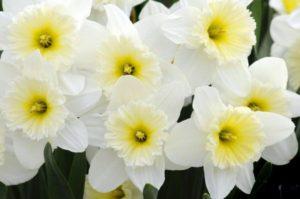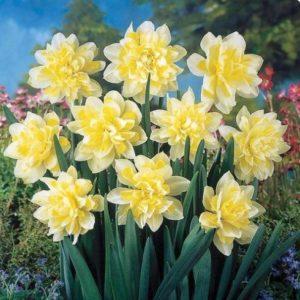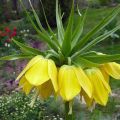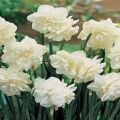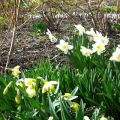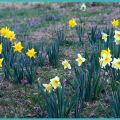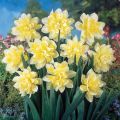Features and rules of planting and caring for daffodils and the secrets of agricultural technology
Daffodils are the first to bloom - that's why they got their name "flowers of spring". Their beauty is not for long, only for a couple of weeks. Daffodils are not capricious, but the landing will have to be done on time, and the care should be organized correctly. Even for the harsh climate, they are well adapted. Do everything right, and large, beautiful flowers will bloom on your site in the spring.
When is the best time to plant daffodils - in spring or autumn?
Which month to plant daffodils depends on the climatic conditions of the area in which you live. In the fall, the bulbs are immediately planted in the ground. In the spring - two months before planting, they will have to be placed in the refrigerator.
What is the advantage of planting in the fall?
Narcissus is a bulbous culture. And it is often planted in the ground in the fall. A good root system, which the bulbs will have time to build up, is a guarantee of the problems of the winter experienced, and the formed buds are a guarantee of strong strong peduncles released on the first warm days.
It can be September, less often - the beginning of October. It is important that the temperature in the soil remains at around 8-10 ° C for two weeks. And then feel free to plant daffodil bulbs. In 3-4 weeks they will take root, and frost will cease to be dangerous for them.
Planting ahead of this time is fraught with unpleasant consequences - in insufficiently cooled soil, the plant will release sprouts, which is very untimely and destructive. Plant later - it will be difficult for the daffodil to overwinter due to the insufficient number of grown roots.
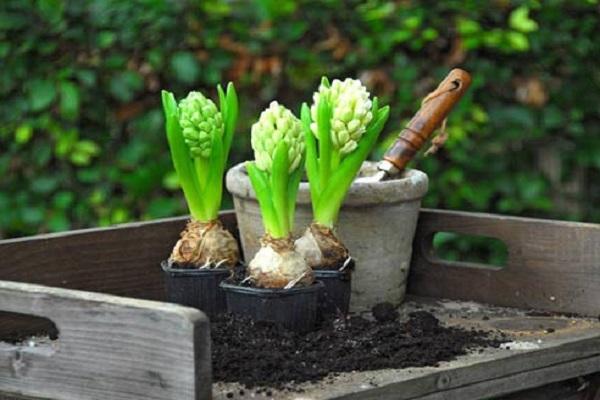
Disadvantages of planting daffodils in the spring
You can, of course, plant flowers in open ground in the spring. You should wait until the soil warms up to a temperature of + 5… + 7 ℃. But you risk being left without flowers. The plant simply does not have time to bloom, since all the forces are thrown into it to take root.
Landing dates in different regions of Russia
It may turn out that you did not meet your schedule. It's already October-November on the street. You can take the risk and still plant daffodil bulbs in the ground. But for this you must live in the southernmost Russian regions and take into account the maximum soil temperature at which planting is possible.
The plant will not be able to adapt and take root in the soil. And you risk being left without flowers in the spring.

In the middle lane
The optimal time for planting bulbs in the gardens of the regions of Central Russia is the first days of September.
In the suburbs and the Leningrad region
If for Moscow Region gardeners and gardeners, the soil temperature reaches the required level between August 15 and September 15, and during this period, having waited for the desired temperature, you can start planting, then for the Leningrad Region this time comes a little earlier - in the second decade of August.
In the Urals, in Siberia
But in the Ural and Siberian regions it is better to start earlier. Depending on the weather, the right time may come both at the end of summer and in September. Although such terms are typical, rather, for Siberia.
In the Urals, with a warm autumn, daffodils are planted in dachas at the same time as in Central Russia. The weather forecast will tell you the optimal time.
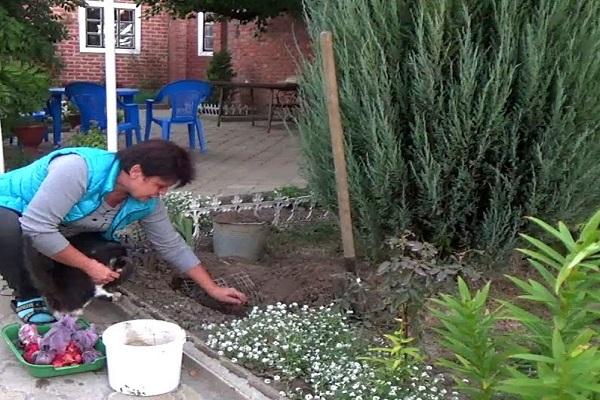
How to store daffodils before planting in the fall
In a faded plant, it is necessary to carefully cut off the buds, wait for the yellow leaves and dig up the bulbs. If you use a garden fork for this purpose, do not damage the material. In reality, this happens 50-60 days after flowering.
Remove old layers, roots and soil from dug out bulbs. It is recommended to treat them with an antiseptic (usually a manganese solution). Be sure to dry them at +22 ... +24 ° С (this will take up to three weeks). Only after all these manipulations are sent for storage in a cool, ventilated room.
Storage conditions:
- +10 ˚С - air temperature;
- up to 70% - humidity.

An important condition: the daffodil bulbs selected for storage must be healthy. This is the only way to grow strong healthy flowers.
How to plant daffodils correctly
An experienced gardener knows that in one place a daffodil fully pleases with exuberant flowering for four years. Then its buds begin to shrink. And this means that it is time to change the place and transplant these wonderful flowers to another area. Do not do this more often. Frequent digging is an extra risk of injury to the plant. This means, and excessive exposure to diseases and pests. And you shouldn't drag out this process for a long time either. The plant is degenerating.
Planting daffodils requires adherence to a certain technology. This is the soil prepared in advance, the dug holes of the required size, the correct fertilization of the flower.
But the first thing a gardener should do is examine the planting material and select healthy bulbs.

Seat selection
This is a very important factor, and choosing the right place for planting is half the battle. Daffodils love partial shade. This way they fade less. They are suitable for flat areas, without drafts. But gusty winds will not prolong their life.
These flowers do not hurt the company, but too much greenery around is undesirable. They are adversely affected by the shadow - they are not able to grow normally, and they do not have a particularly rich aroma, and cannot boast of their size.
There is one more circumstance that will have to be taken into account when choosing a place for flowers - the level of groundwater. It should be no higher than 60 centimeters. Otherwise, you risk rotting the root system.

Land preparation
Daffodils do not require a special type of soil. They will grow in any. But in order for them to develop fully, they need fertile humus loams. There are no such, it is enough to fertilize the soil with compost or humus. If the land on the site is sandy, it is worth adding a clay substrate to it, mixed in equal proportions with peat. It is necessary to dig up the garden 3-4 weeks before planting. Digging depth - up to 40 centimeters.
It is important to know that daffodils do not tolerate manure. Do without it.
Fertilizing the soil
Even in summer, it is recommended to dig up a plot for flowers and fertilize with compost at the rate of 4 kilograms per 1 square meter. In addition, 2 tablespoons of superphosphate and 1 tablespoon of Agricola should be added. Now dig it up again and leave it like this until autumn.

How deep to plant daffodils
The planting depth of these flowers depends on the size of the bulbs and the composition of the soil. It is equal to three times the height of the onion and varies between 10-25 centimeters.
Preparing the bulbs for planting
One sick bulb is enough to infect healthy specimens and soil and introduce pests into it. Therefore, a week before disembarkation, they should be sorted out and discarded all unhealthy specimens - those that are damaged, rotted or infected.
A healthy bulb should have dry scales, golden or brown shades. To the touch, each should be dense, with an even dry bottom, solid, without any stains, deposits and mold.
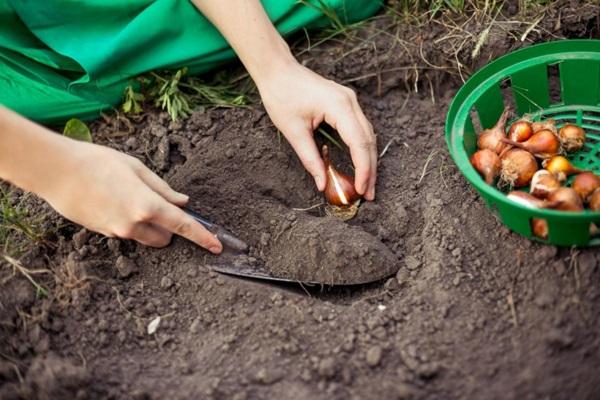
The cracked scales must be removed from the bulbs that you have selected. They come off easily. You may only need to get rid of a couple of top layers.
Planting daffodils
You will have to adhere to a certain landing pattern:
- water the wells prepared in advance;
- pour sifted river sand on the bottom;
- lay the bulbs down with their bottoms, pushing them a little into the ground;
- sprinkle each one with ash first, then earth.
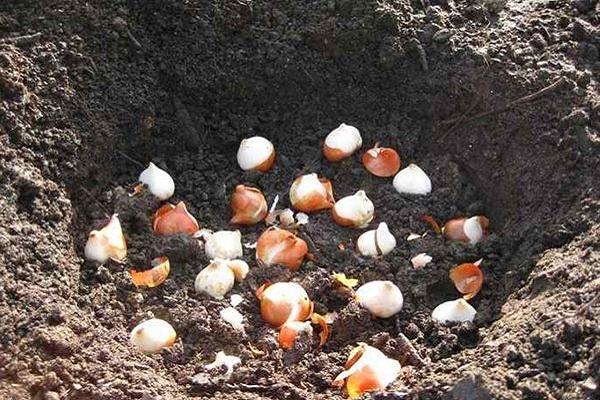
Do not forget to cover the soil with a protective layer. So you can protect it from the winter cold. Peat or humus is suitable for this. Enough thickness of 5 centimeters. If you cover with leaves, the layer should be thick, not less than twenty centimeters. You will remove them in the spring.
At what distance to plant bulbs
Small-flowered varieties are planted every 6-10 centimeters, in groups or paths.
Large specimens - at a distance of 15-20 centimeters from each other, usually one flower at a time, but it is possible in groups.

Caring for daffodils after planting
In order for your daffodils to grow well and bloom profusely, they need to be well cared for: feed, water, weed and loosen.
- Top dressing. There should be 4 of them during the season. The first three - nitrophoska under the flowers - first in the spring, while they germinate, then - at the moment the buds appear and the third time - at the time of flowering. And after it, you need to feed the flower for the last, fourth time, using phosphorus-potassium fertilizers.
- Watering. These flowers require a lot of moisture. And you will have to water even a couple of weeks after they have faded. Be sure to do this during feeding, so as not to burn the roots.
- Withering buds must be removed.
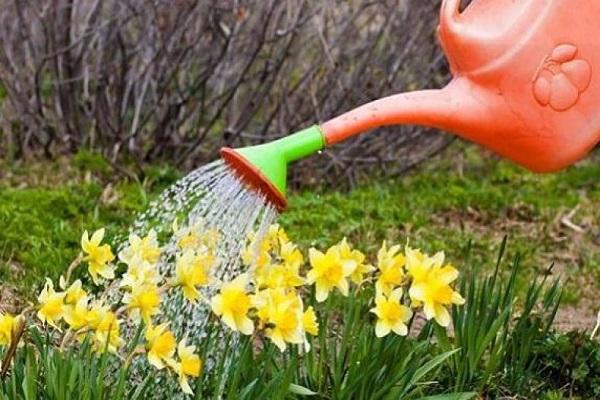
Reproduction of daffodils
You can propagate this flower yourself. It is enough to make small cuts at the bottom of the bulb and wait for new bulbs to appear in the cuts. After a while, they will become a good planting material.
In the last days of summer, divide the bulb - two scales should be strengthened on one bottom. Pack it in a bag with perlite and store it like that. In this form, and planted in the ground.
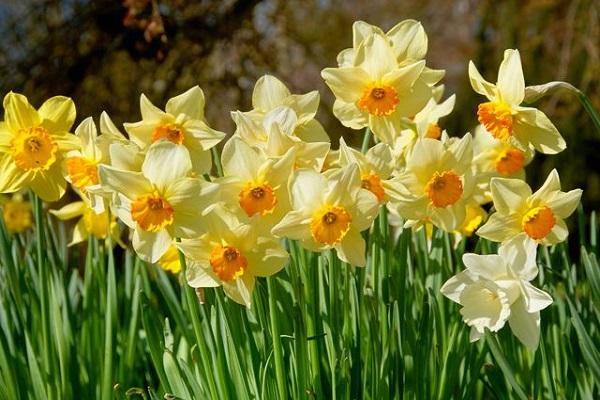
Many people love to grow daffodils. They are like a symbol of the coming spring. More than 12 thousand varieties to choose from. Someone prefers flowers on the windowsill, but there is nothing like a blooming flower bed right under your window. This business is within the power of even an inexperienced amateur. Daffodils have long adapted to the Russian climate and winter freely in open ground.
If you follow our recommendations, daffodils will delight you with magnificent blooms every spring.
